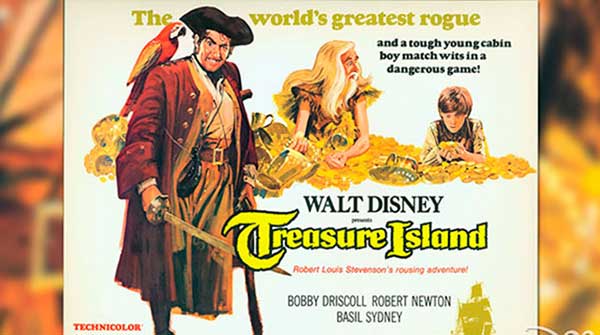Treasure Island, with its iconic characters and thrilling plot twists, is the classic adventure that never grows old
Fifteen men on the dead man’s chest
Yo-ho-ho and a bottle of rum!
Drink and the devil had done for the rest
Yo-ho-ho and a bottle of rum!

For interview requests, click here
Having just hit one of those significant chronological milestones, I was of a mind to revisit the first novel I remember reading in full – Robert Louis Stevenson’s Treasure Island. The verse quoted above, created by Stevenson as a fictional pirate sea shanty, has stayed with me over the years.
Published in 1883, Treasure Island was Stevenson’s first commercially successful book and became a children’s classic for many succeeding generations. Others followed, such as Kidnapped and The Master of Ballantrae, but Treasure Island’s blend of piracy, buried treasure and adventure was never surpassed. Naturally, Hollywood loved it.
I was seven years old when I read it, prompted by having just seen the 1950 film version that eventually made its way to our small local cinema. That’s the one in which English actor Robert Newton’s interpretation of Long John Silver wrote the book on how pirates were to be portrayed on screen.
So I found a large print edition of Treasure Island put together in 2017 by James Hart. It’s handsomely produced, contains the full text plus background extras, and is also annotated to explain terminology that modern readers might not be familiar with.
 |
| Recommended |
| How extraterrestrials took over our culture
|
| Wyatt Earp and Bat Masterson were the dynamic duo of frontier justice
|
| Fantagraphics Books unveils new comic collections
|
What, then, was it like revisiting Treasure Island after all these years?
The opening paragraph was instantly familiar. Told through the voice of the story’s primary narrator, cabin boy Jim Hawkins, it sets the stage for the tale to come:
“Squire Trelawney, Dr. Livesey, and the rest of these gentlemen having asked me to write down the whole particulars about Treasure Island, from the beginning to the end, keeping nothing back but the bearings of the island, and that only because there is treasure not yet lifted, I take up my pen in the year of grace 17_ and go back to the time when my father kept the Admiral Benbow inn and the brown old seaman with the sabre cut first took up his lodging under our roof.”
From there, we’re away to the races and the various half-forgotten characters present themselves. In addition to those already mentioned, there’s the sinister Blind Pew, the creepy Black Dog, the haplessly marooned Ben Gunn, the stalwart Captain Smollett, and the murderous Israel Hands.
Several plot elements drive the action along.
We have the discovery of the mysterious map purportedly identifying the location of Captain Flint’s buried treasure; the commissioning of the sailing ship Hispaniola to venture out from Bristol in search of the island; the infiltration of the crew by pirates led by the charismatic, one-legged Long John Silver, who is ostensibly the cook but actually much more; the mutiny on the island; finding the treasure; and Silver’s escape en route back to England.
While the book is an easy read, I did find myself wondering how my seven-year-old self would’ve coped with some of the extended passages. Perhaps my memories are a blend of the film, the novel and the Classics Illustrated adaptation – a genre that was extremely popular at the time (it was, for instance, how I first became acquainted with Shakespeare’s Macbeth). But whatever mix might have provided my original sources, Treasure Island remains a near-perfect example of what would’ve once been described as a ripping adventure yarn.
Although a self-identified “red-hot socialist” in his youth, Stevenson was at heart a Tory. Or at least he was by the time he wrote Treasure Island.
In addition to having its fair share of baddies, the book features good people of all social classes. And hierarchy notwithstanding, the fundamental order of society is depicted as morally sound. The book’s adult hero, Dr. Livesey, epitomizes this.
Both a medical doctor and a magistrate, Livesey is an admirable character. He’s authoritative, prudent, decisive and universally respected. When trouble beckons, people instinctively turn to him.
And while thoroughly decent, as evidenced by his willingness to treat wounded pirates during a truce in the fighting on the island, he’s also unflinching in his pursuit of justice. When the fugitive pirate who arrived at the Admiral Benbow inn – Billy Bones – threateningly wields a knife during one of his drunken rants, Livesey instructs him to put it away or “upon my honour, you shall hang at the next assizes.”
Simpler times!
Troy Media columnist Pat Murphy casts a history buff’s eye at the goings-on in our world. Never cynical – well, perhaps a little bit.
The opinions expressed by our columnists and contributors are theirs alone and do not inherently or expressly reflect the views of our publication.
Troy Media
Troy Media is an editorial content provider to media outlets and its own hosted community news outlets across Canada.


